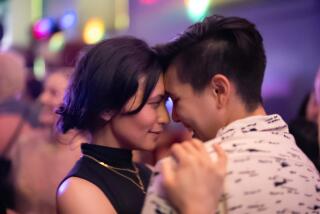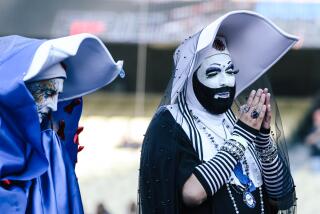Fight for Gay Rights Started Early in L.A.
- Share via
“One flower hits me,” snapped the policeman, “and you’re going to be charged with assault on a police officer.” It was 3 a.m. on an August night in 1968. In the lobby of the Harbor Division police station stood two dozen men, flourishing sprays of gladioli, daisies and roses.
They were there in protest, gathered in a singularly ‘60s marriage of flower power and gay camp. Hours earlier, Los Angeles police had swept into the Patch, a popular gay club in Wilmington, and hauled away two customers on morals charges.
Fed up with police raids, Patch co-owner and manager Lee Glaze exhorted the bar crowd not to be intimidated. Armed with flowers from a customer’s shop, he then led a band of patrons to the police station, where they milled around the lobby with their wilting bouquets until the arrestees were released on bail at the approach of dawn.
Nearly a year later in New York City, there would be another protest--this time big, ugly and violent--against a police raid on a crummy Greenwich Village gay bar called the Stonewall Inn. Scores were injured as they fought with police, returning to the streets again and again over a period of five days. In the annals of modern American gay history, the Stonewall riots of June 28, 1969, are known as the torch that lit the gay rights movement, that fired the previously quiescent gay masses into organized action and resistance.
But like any movement’s defining moment, Stonewall could not have happened without many mini-moments in the years before. As Stonewall’s 25th anniversary is observed in New York this weekend with celebrations and a huge gay rights demonstration in Manhattan, some of the sturdiest roots of that rebellion can be traced across the country to California and Los Angeles.
Be it the 1951 formation of the Mattachine Society--the first lasting gay political organization in the nation, the 1953 publication of One--the first widely circulated, explicitly gay magazine in the country, or the petal protest at the Harbor station, the seeds of revolution were being sown in Los Angeles.
Of course, Glaze did not look at it quite that way. He was just mad. “Hey, enough, enough,” he remembers thinking. Not only were the cops once again harassing his customers, but the arrests were particularly outlandish. The two men accused of lewdly groping one another were both interested in the same man--but they were not interested in each other and certainly had not shared any intimacies.
“How could you possibly arrest two queens who hated each other?” Glaze, 59, still wonders. He is sitting in his art-stuffed Long Beach apartment, flipping through the pages of a scrapbook fat with snapshots of bell-bottomed and occasionally bewigged friends--many of whom have died of AIDS. “All of these kids,” he sighs, gazing back into a world now gone.
He turns more pages, settling on black-and-white blowups taken of the police station visit by an off-duty news photographer, a Patch regular. The photos document more camp than rage. The camera freezes the young men, grinning in their Nehru shirts under the police station sign. Glaze vamps by the front desk, clutching a lavishly ribboned bouquet.
Yet for the time, it was an act of uncommon defiance, duly noted in the infant Los Angeles Advocate, which later evolved into one of the country’s leading gay magazines.
Describing the arrests and Glaze’s speech to his customers--”All we want is to be left alone in our own bars”--the Advocate reporter wrote expectantly: “If the reaction of the customers there that night is any indication, a new era of determined resistance may be dawning for L.A.’s gay community.”
In fact, the Patch protest had a ripple effect, according to gay archivist and veteran activist Jim Kepner. In the following months several gay organizations were founded: a legal aid group, a theater and film club and the Metropolitan Community Church, which now boasts of congregations worldwide.
To belong to such groups was still daring. It was an era when Los Angeles police were arresting thousands of homosexuals a year on morals charges. California, along with virtually every other state, had sodomy laws criminalizing gay sex. In gay clubs, simply dancing together or touching could bring the vice cops running.
To be gay was, in effect, illegal.
Bar raids were routine and sometimes brutal. “People were hauled out and thrown down on the sidewalk,” said Kepner, remembering a place called the Red Raven. Charges were often trumped up. No sooner had one man gotten in the door, Kepner recalled, than he was arrested for performing sex acts in the middle of the floor.
In 1967, when gays joined a number of minority communities protesting police brutality in Los Angeles, the organizers forbade them to utter the words gay or homosexual.
And so when Kepner addressed a rally of about 200 demonstrators outside a Silver Lake gay bar called the Black Cat, he told the crowd: “We won’t say who we are tonight, but look around. . . . We promise that after tonight, the ‘love that dared not speak its name’ will never be quiet!”
By the late 1960s, Kepner was already a seasoned gay activist. He had joined the Mattachine Society in 1953, when the very concept of organizing for what was then known as the “homophile” cause was radical, even dangerous. Later he edited One, which had to go to the U.S. Supreme Court to overturn an order blocking the magazine’s distribution by the U.S. Postal Service.
In 1956, decades before gay studies programs made their way into college curricula, Kepner was teaching a few gay studies classes at One’s Downtown offices.
Even after years of such stirrings, however, the climate remained icy. Life magazine, writing in 1964 about the “sad and often sordid world” of homosexuals, alluded to the running battle between Los Angeles police and gays.
“As part of its anti-homosexual drive,” the article stated, “the Los Angeles police force has compiled an ‘educational’ pamphlet . . . entitled ‘Some Characteristics of the Homosexual.’ The strongly opinionated pamphlet includes the warning that what homosexuals really want is a ‘fruit world.’ ”
Against such a backdrop, most gay men and lesbians lived in a shadow world governed by the tenets still embodied in today’s policies on gays in the military: Don’t ask. Don’t tell. And if you do, you could lose everything.
One of Glaze’s customers--a schoolteacher arrested outside of the Patch sometime before the August raid--was so distraught at being exposed that he committed suicide.
Judy Twentyman, a Northridge financial adviser, recalled: “In 1969, I was in the closet. My lover was in the closet. All my friends were in the closet. That was life. . . . It seemed perfectly normal to me. I couldn’t imagine living any other way.”
So tightly was the closet door shut, that Twentyman says many of her contemporaries remain behind it.
“Homophobia is very deeply ingrained in our era,” the 54-year-old said. “It’s kind of like going through the Depression or the Holocaust. All those events shape people in a certain way. That’s the reality you lived and it’s real forever.”
When Chuck Murphy, 56, and Al Barney, 66, bought a house together in Manhattan Beach in 1963, an insurance agent said he could not possibly sell a homeowner’s policy to two men. For their housewarming party, the couple carefully arranged the bedrooms to make it appear that they slept apart--and explained the house purchase as a business deal entered into solely for tax breaks. If they went to gay bars--usually sign-less and windowless--they carefully scanned the street to see if anyone was watching before ducking inside.
The two heard of the Stonewall riots in New York, but at the time, did not attach much significance to them. If anything, Murphy said, he disapproved of the bottle- and brick-tossing clash with police. “I don’t think violence is necessary.”
Now he feels comfortable enough to display gay pride symbols in his car windows.
Stonewall was not even a blip on Bonnie Wilkerson’s radar screen. She remembers the 1950s and ‘60s as “the pits” for gay people. “You couldn’t tell anybody. If you did, you were really ostracized.”
One dared not utter the word lesbian . “It was always a taboo word,” said Wilkerson, 78, who lives in Huntington Beach. “In fact, it took me quite a while to say it.”
She was an architect working in Orange County in what she calls “a man’s world” and was closeted her entire career. If she saw any glimmers of the gay revolution, she did not run to the barricades.
“I felt powerless. I’m not one to stir up the pot,” she said.
For others, the scent of change was intoxicating.
When Myra Riddell heard about the Greenwich Village insurgency from New York friends, she knew it would have an effect. “I thought it was just great, that it was going to be the start of something,” she said.
From the time she left her marriage in the mid-1950s and ran off to Europe with another woman, she had been open about her homosexuality. “I told everybody. . . . I thought it was just wonderful and the result was a big flap,” said Riddell, 67, who lives in the Hollywood Hills and is president of the Los Angeles County Commission for Women.
Flap or no, she remained open. “I don’t know, I guess I’ve always been a rebel,” she said. Within a couple of years of the Stonewall riots, she was working in the gay movement. In 1975, she helped found Southern California Women for Understanding--carefully named to avoid any gay overtones, but a lesbian group nonetheless.
Before Stonewall, Kepner noted, many gays sought validation from the authorities. “After Stonewall we gave the authorities the finger for a while.”
In late 1969, a small group picketed the Los Angeles Times, protesting the newspaper’s refusal to print advertisements for the Homosexual Information Center of West Hollywood. (A Times official said the ads failed to meet the paper’s “standards of acceptability.”)
A month later, a Los Angeles branch of the new Gay Liberation Front was born. In June, 1970, activists went to court to help clear the way for a “gay power” parade down Hollywood Boulevard to commemorate the first Stonewall anniversary.
More than 500 demonstrators marched to catcalls and cheers.
Gay pride had arrived.
More to Read
Sign up for Essential California
The most important California stories and recommendations in your inbox every morning.
You may occasionally receive promotional content from the Los Angeles Times.











